Regulating the Global Commons – Part II
Regulating the Global Commons – Part II
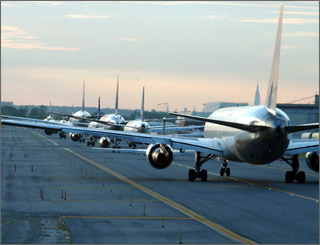
SINGAPORE: Those who care about global climate change should pause before buying imported goods or flying abroad for a holiday, or so many environmental activists urge. Ships and planes are the backbone of international trade and travel, yet largely evade political scrutiny as sources of harmful air pollution and greenhouse gas emissions that contribute to climate change.
The world’s fleet of 50,000 oceangoing vessels, in international waters far from land for much of the time, keeps a low profile on the greenhouse radar screen. Meanwhile, the 15,000 large jet aircraft that carry millions of passengers around the world have not yet been hit with the kind of carbon curbs and taxes being planned for energy-intensive industries because governments are reluctant to cap popular demands for cheap mass travel by air.
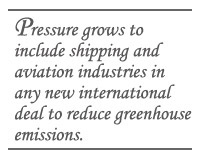
However, as public concerns intensify about climate change, pressure is growing to include both the shipping and aviation industries in any new international deal to reduce greenhouse emissions. Neither is covered by the Kyoto Protocol, which expires in 2012, in part because of the complexity of attributing emissions from ships and planes to individual states. Their inclusion in any Kyoto successor has major implications for trillion-dollar industries that must constantly invest in expensive new equipment and facilities to deliver cost-efficient service and stay competitive. Ships carry 90 percent of trade by volume, including bulk commodities like oil and minerals and container cargoes of manufactured goods. In addition to passengers, planes carry high-value perishable items and products for the far-flung global supply chain on a just-in-time basis.
Major ports in Asia, Europe and North America closely follow any clean-up proposals for shipping because they’ll add substantially to business costs and could give some maritime centers a competitive advantage unless the new controls are enforced by all trading nations. Airlines, too, are concerned at the prospect of regulation and foresee substantial extra costs as many operators struggle to make profits amid rising fuel prices and cut-throat competition.
Much will depend on which emissions regulators tackle and how. For example, the European Union provisionally includes aviation, but not shipping, in its emissions-trading scheme. The shipping industry argues that its carbon footprint is relatively small: Carrying goods by sea on vessels that burn oil-based fuel produces less than 2 percent of the CO2 that would be generated by freighting the same goods the same distance by air. Compared with rail, the CO2 saving of sea transport would be 50 percent while with road transport using heavy trucks, it would be around 15 percent, according to this calculation.
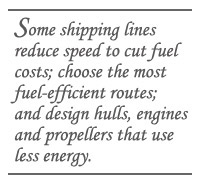
Nonetheless, a study by a group of industry experts released in February concluded that annual CO2 emissions from shipping reached 1.12 billion metric tons in 2007, about 3.5 percent of global releases and nearly double the 650 million tons attributed to aviation. But ships are also a source of non-CO2 pollution. The International Council on Clean Transportation, made up of transport and air quality officials from a wide range of states, reported last year that ships produced more sulfur dioxide than all the world’s cars, trucks and buses combined. Environmental groups say that ships account for between 8 and 10 percent of sulfur emissions from all types of fossil fuel and also contribute nearly 30 percent of global releases of nitrogen oxides.
Seaborne trade has surged by 50 percent in the last 15 years and is expected to continue expanding fast. In November, reacting to public concern about pollution from ships, the European Commission called on the International Maritime Organisation, the United Nations agency responsible for regulating marine pollution, to do more to combat climate change. Proposals under review include tightening fuel standards, reducing funnel exhaust gases and using only shore-based electric power when in port. They could be adopted by the IMO as amendments to global marine pollution laws as early as October and come into force in 2010. Reacting to calls for a cleaner industry, some shipping lines reduce speed to cut fuel costs; choose the most fuel-efficient routes; and design vessels with hulls, engines and propellers that use less energy. They have found that slowing a ship by 10 percent can result in a 25 percent reduction in fuel use.
While the IMO seeks international consensus, pressure builds in the US and Europe for national and regional regulation. If the IMO fails to produce credible and enforceable standards, sea-based transportation will be saddled with a patchwork quilt of regulations, slowing trade and increasing costs.
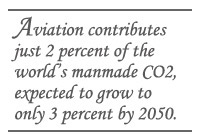
Meanwhile, environmental groups target aviation’s impact on global warming, although scientists on the UN’s Intergovernmental Panel on Climate Change estimate that aviation contributes just 2 percent of the world’s manmade CO2, expected to grow to only 3 percent by 2050. Giovanni Bisignani, director-general of the International Air Transport Association, says that airline fuel efficiency has improved by 70 percent in the last 40 years, on target to achieve a further 25 percent gain by 2020. He adds that improvements in aircraft operations and traffic management, as well as advances in design, limit annual growth of the aviation industry’s carbon footprint to 3 percent, even as air travel expands by about 6 percent a year.
However, critics assert that the airline industry underestimates its contribution to global warming and that improved technologies for reducing pollution will be more than offset by the sheer growth of aviation, particularly in Asia, North America and Europe. A recent report by Britain’s Royal Commission on Environmental Protection found that the net effects of ozone gas from planes, aircraft condensation trails and aviation-induced cloud cover is likely to triple the warming effect of aircraft emissions. The report concluded that if these estimates are correct and anticipated growth in plane travel occurs, aviation may be responsible for up to 10 percent of the human impact on climate by the year 2050.
There’s no doubt the industry is growing fast. Its latest forecast, European aircraft maker Airbus says the world’s fleet of large passenger jets, more than 100 seats, will double in the next 20 years to nearly 33,000 aircraft. Airfreight will rise by 5.8 percent annually in the same period. The greatest demand will come from the Asia-Pacific region. A big rise in the number of planes would mean more emissions, followed by increased pressure on makers of aircraft and their engines to cut pollution.
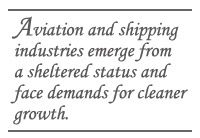
Europe is taking strides to lead the world in campaign to reduce greenhouse gas emissions and has drafted controversial plans to make all airlines flying in and out of the bloc buy pollution permits. The European Commission proposed in January that airlines using EU airports would be included in the bloc’s emissions-trading scheme from 2012. Under the scheme, yet to be approved by the European Parliament and the 27 member-states of the EU, airlines would gradually have to buy emissions certificates at auction.
The US government and many airlines insist there should be an international agreement first. They warn that without it, European airlines would risk retaliation, including denied access or punitive taxes in other countries. Non-European airlines might shun Europe as a hub for long-haul flights.
One thing is clear: As the aviation and shipping industries emerge from their sheltered status and face up to demands for cleaner growth, they will be under the same pressure as other significant contributors to climate change to show that expansion no longer takes an unacceptable toll on the environment.
Michael Richardson, a former Asia editor of the International Herald Tribune, researches transportation, energy and climate change at the Institute of South East Asian Studies in Singapore.